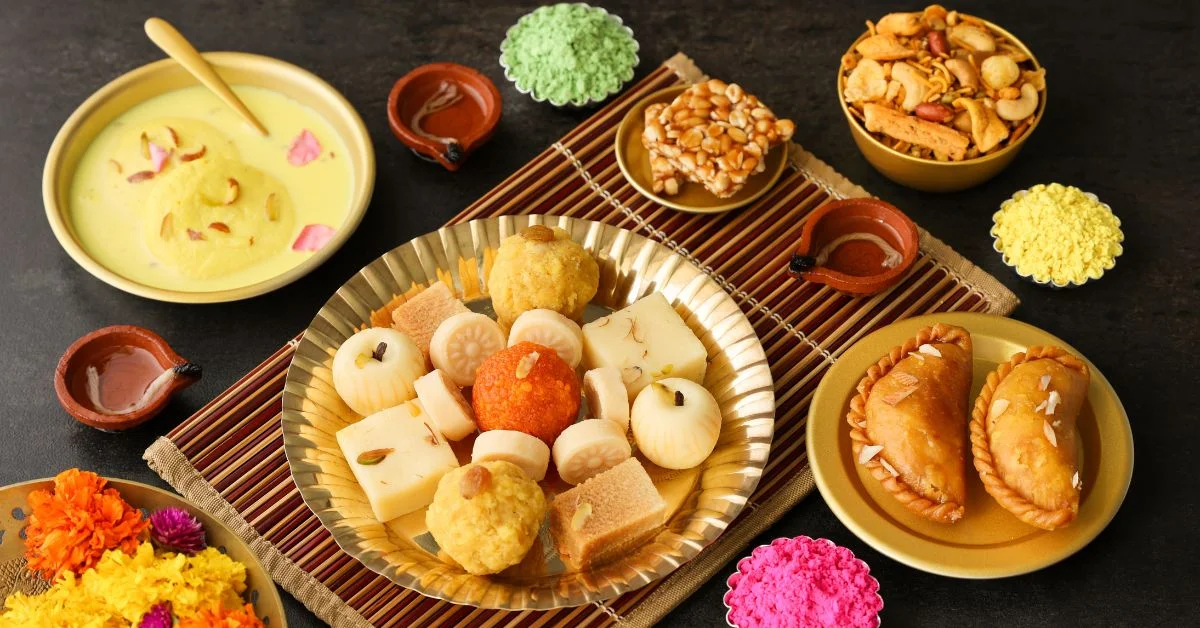Chandrakala Mithai, a name that rings with both poetic charm and culinary intrigue, is one of India’s lesser-known but deeply beloved traditional sweets. Often compared to gujiya due to its shape and stuffing, Chandrakala distinguishes itself through its intricate preparation, rich filling, and symbolic presence during festivals, especially in North India.
For someone encountering this sweet for the first time, the search intent is clear: What is Chandrakala Mithai? Where did it originate? What makes it unique? Is it still made today, and if so, how? This article addresses those questions and more, offering a complete informational guide to this treasured Indian dessert.
What Is Chandrakala Mithai?
Chandrakala Mithai is a traditional North Indian sweet, typically made during festivals like Holi and Diwali. It consists of a semi-circular dumpling made of all-purpose flour (maida), filled with a sweet mixture of khoya (thickened milk solids), grated coconut, dry fruits, and sugar, sealed like a pastry, deep-fried until golden, and finally dipped in sugar syrup.
Its crescent shape and delicate folds resemble a half-moon—hence the name “Chandrakala,” which literally translates to “moon phase” in Hindi and Sanskrit. While gujiyas are more commonly made in the plains of Uttar Pradesh and Bihar, Chandrakala is considered the more ornate, royal cousin of the gujiya.
Origin and Cultural Roots
The exact historical origin of Chandrakala Mithai is difficult to pinpoint, but it is strongly rooted in the cuisine of Uttar Pradesh and Bihar, particularly in festive or ceremonial cooking.
Chandrakala is believed to have originated from Mithila (a cultural region covering parts of Bihar and Nepal) or from Awadh, where courtly cooking traditions emphasized artistic sweets and elaborate festive fare.
In these regions, Chandrakala was:
- Offered during festivals like Holi, Diwali, and Raksha Bandhan
- Prepared for weddings and religious ceremonies
- Shared among extended families during harvest or seasonal feasts
Its detailed preparation and richness marked it as a luxury sweet, meant for occasions of joy, prosperity, and togetherness.
Key Ingredients in Chandrakala Mithai
Chandrakala may seem simple at first glance, but its layers of texture and flavor come from carefully chosen ingredients. Here’s a breakdown of the typical components:
1. Outer Shell
- Maida (Refined Flour): Used for the dough, which is kneaded until smooth.
- Ghee or Oil: Incorporated into the dough for flakiness.
- Water or Milk: To bind the flour.
2. Filling
- Khoya (Mawa): Reduced milk solids, the heart of the filling.
- Grated Dry Coconut: Adds texture and a nutty-sweet balance.
- Chopped Dry Fruits: Cashews, almonds, raisins, and pistachios.
- Sugar or Boora (powdered jaggery): Sweetens the mixture.
- Cardamom Powder: For aroma and flavor.
- Saffron or Nutmeg (optional): For richness.
3. Sugar Syrup
- Made by boiling sugar and water, sometimes with a dash of rosewater or kewra for aroma.
- Chandrakala is dipped into this syrup after frying, absorbing a glossy sheen and added sweetness.
Step-by-Step Preparation Process
Here’s how a traditional Chandrakala Mithai is made at home or by halwais (sweetmakers) in sweet shops across North India:
1. Dough Preparation
- Mix maida with a few tablespoons of melted ghee.
- Add water gradually to knead into a firm yet pliable dough.
- Cover and let it rest for 30 minutes.
2. Filling Preparation
- Dry roast khoya until it lightly browns.
- Mix in sugar, dry fruits, grated coconut, and cardamom powder.
- Allow to cool before using.
3. Shaping the Sweets
- Roll out small discs from the dough.
- Place filling in the center.
- Fold over to make a semicircle, and crimp the edges into decorative pleats using fingers or a fork.
4. Deep Frying
- Heat ghee or oil in a deep pan.
- Fry the stuffed sweets on low to medium heat until golden brown.
5. Sugar Syrup Soaking
- Dip the hot Chandrakala pieces into warm sugar syrup for 3–5 minutes.
- Remove and let cool on a plate lined with parchment or banana leaves.
The final product is golden, crisp on the outside, juicy on the inside, and visually stunning.
Variations Across Regions
Though primarily associated with Uttar Pradesh and Bihar, Chandrakala has inspired several variations across India.
| Region | Variant Name | Key Differences |
|---|---|---|
| Bihar | Chandrakala (original) | Rich filling, dipped in sugar syrup |
| UP (Eastern) | Pedewali Gujiya | Stuffed with peda instead of khoya |
| Rajasthan | Mawa Kachori | Fried, stuffed with khoya, soaked in syrup |
| Maharashtra | Karanji | Coconut-heavy, not always soaked in syrup |
| South India | Sugiyan (Tamil Nadu) | Made with chana dal and jaggery, coated in rice flour |
Each variation reflects local ingredients, climate, and culinary preferences, but the underlying idea remains the same: a celebration sweet, made with love and time.
Chandrakala in Festivals and Religious Ceremonies
Chandrakala is most commonly prepared during Holi, the festival of colors, where its sweetness counters the fiery spirit of celebration. Families prepare it alongside:
- Gujiya
- Dahi Bhalla
- Thandai
- Kachoris
In Bihari weddings, Chandrakala is part of the “mithai ka tokra” or sweet hampers gifted to the groom’s family. It’s also sometimes prepared during Durga Puja or Chhath Puja, especially in Mithila regions.
The meticulous crimping of its edges is often a symbol of patience and skill, passed from grandmothers to daughters-in-law, reinforcing family bonds through the act of cooking.
Modern Interpretations and Innovations
As sweet shops modernize and home bakers experiment, Chandrakala has begun to evolve:
- Baked Chandrakala: Healthier versions using convection ovens instead of deep frying.
- Chocolate Chandrakala: Incorporating cocoa, chocolate chips, or Nutella in the filling.
- Fusion Flavors: Rose-cardamom mousse or even cheesecake-style fillings.
- Mini Chandrakalas: Bite-sized versions for modern presentation and portion control.
Instagram and YouTube food creators have also helped revive this forgotten gem, bringing it to the attention of younger generations.
Nutritional Value and Considerations
Like many Indian sweets, Chandrakala is an occasional indulgence, rich in:
- Calories: From deep frying and sugar syrup.
- Fats: Especially saturated fats from ghee.
- Natural sugars: From khoya and dry fruits.
For health-conscious users:
- Opt for baked versions
- Use jaggery instead of refined sugar
- Replace maida with whole wheat flour
- Use air-frying techniques
That said, its cultural and emotional value far outweighs calorie counts—a fact most Indian families acknowledge during festive times.
Where to Buy Authentic Chandrakala Mithai
In India, Chandrakala is mostly sold in halwai shops in Bihar, Varanasi, Gorakhpur, and parts of Eastern Uttar Pradesh.
Famous Sweet Shops Offering Chandrakala:
- Tiwari Sweets (Patna)
- Kaleva (Delhi)
- Shree Ram Bhandar (Varanasi)
- Bengali Market Sweets (Delhi NCR)
In metro cities, Chandrakala can often be custom-ordered from traditional mithai stores or specialty sweet-makers during Holi or Diwali.
Why Chandrakala Mithai Is Making a Comeback
In a world flooded with fast food and instant gratification, Chandrakala represents something different:
- Time-honored tradition
- Culinary craftsmanship
- Family bonding
- Ritual and festivity
Its resurgence can be credited to:
- YouTube recipe creators
- Instagram food bloggers focusing on traditional recipes
- Heritage food festivals in urban India
- Conscious eating movements that celebrate slow, artisanal food
Chandrakala is a story, not just a sweet.
Conclusion
Chandrakala Mithai is more than a festive dessert—it is a piece of India’s living culinary heritage. With its ornate shape, rich filling, and deep cultural roots, it continues to bind generations together through flavor and tradition. Whether made in a grandmother’s kitchen or picked up from a sweet shop in Patna, Chandrakala is a reminder of celebration, hospitality, and patience.
As India balances modern tastes with traditional wisdom, sweets like Chandrakala remind us that food is memory, emotion, and identity—wrapped in dough, fried to perfection, and dipped in sweetness.
FAQs
1. What is Chandrakala Mithai made of?
Chandrakala Mithai is made from refined flour dough filled with khoya, dry fruits, and coconut, deep-fried and soaked in sugar syrup.
2. Is Chandrakala the same as Gujiya?
While similar in shape, Chandrakala has more intricate sealing and often richer fillings. It’s considered a more decorative and ceremonial sweet.
3. Where did Chandrakala Mithai originate?
Chandrakala is believed to have originated in Bihar or Eastern Uttar Pradesh, particularly in regions like Mithila and Awadh.
4. Can Chandrakala be made healthier?
Yes. It can be baked instead of fried, and sweetened with jaggery instead of sugar. Whole wheat flour can replace maida for the dough.
5. Where can I buy Chandrakala Mithai?
It is available in traditional sweet shops across Bihar, UP, Delhi, and Varanasi. It can also be custom-ordered during Holi or Diwali.
For more information, click here.









